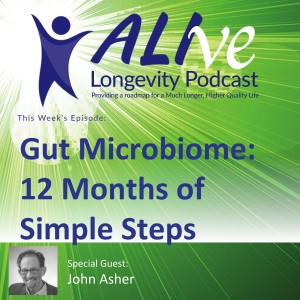Monday Nov 30, 2020
Gut Microbiome - Simple Steps to Turn Your Diet and Health Around


Eating a diet tuned for a healthy gut microbiome is needed in order to preclude 11 diseases and three conditions. Let's talk about what we eat. John gives us two sample daily menus and 12 steps that won't overwhelm you as you create a healthy gut microbiome. John gives us two examples of his own menus.
"This is actually a typical day for me. Breakfast, I'm going to eat a closed fistful each of walnuts, pistachios and macadamia nuts and a cup of mixed berries, including about half of them will be raspberries because of their prebiotic nature and high fiber content. For lunch, I almost always have a smoothie and the reason is if you try to eat a great big salad, it could take 15-20 minutes, you can drink a smoothie in about three minutes. So I'll make 6 smoothies at once in a big blender, I'll put in eight leafy green vegetables, half of an avocado, a green banana, low sugar content, 6 ounces of goat yogurt, a teaspoon each of hemp hearts and flax seed, sauerkraut, olive oil and coconut milk unsweetened as a liquid, and then seven different hermetic spices that we'll talk about in step 6.
And then for dinner, I'll add 4 ounces of fish, poultry or red meat once a week, cook with low heat, steamed or roasted vegetables and mushrooms with olive oil. And then for dessert, say two figs, either fresh or dried. And now when you buy dried fruit, you have one or two choices, it'll have sugar and oil added, or it'll be just the fruit. So if you're going to eat dried fruit, which I like, then make sure it's just the fruit and organic. Here's another typical day when you're following this routine, breakfast might be two eggs cooked in olive oil with low heat and a cup of fruit and a cup of fruit with those great vegetables with all that fiber in them, orange, apple, tart cherries. Lunch might be a large salad with mushrooms, mobile leafy greens and other low-glycemic vegetables with olive oil and vinegar dressing, and then dinner again for us is a fish, poultry or red meat cooked with low heat, steamed broccoli, cauliflower, and fennel, and then a coconut milk ice cream bar.
There's just a ton of opportunity to buy, other than ice cream, which is a highly processed food, there's lots of non-dairy ice cream. The one John likes is the So Delicious brand and it's got about 150 calories per ice cream bar with all the good ingredients."
This sounds like an awful lot and so, what we've come up with that's on our website, you can take a look at is if you are going to transfer from eating a Western diet and having a bad microbiome full of bad bacteria and you wanted to shift, doing everything John suggested in this podcast is a lot of stuff to do. We've cut it to 12 steps. So if you and your partner said, "Okay, we want to shift, but we can't be crazy about this and we just took one step a month, what would that look like?"
- Month One, just start eating much less processed foods.
- Month Two, start consuming much less sugar and artificial sugar substitutes. Shift to those natural sugars.
- Month Three, eat red meat only once a week and only grass-fed with no antibiotics or hormones.
- Month Four shift how you buy fish and shellfish shift to only wild-caught, again with no antibiotics or hormones.
- Month Five, eat poultry infrequently and again, only pasture-raised with no antibiotics or hormones.
- Month Six, increase consumption of protein from nuts, mushrooms, and leafy green vegetables.
- Month seven, start buying mainly organic food. That's why I always shop at Whole Foods. It's mainly organic foods, meaning no pesticides.
- Month Eight just cut out all grains, legumes unless they're pressure cooked.
- Month Nine, start eating a low glycemic, low sugar content fruits and vegetables frequently.
- Month 10 substitute goat and sheep products for cattle and dairy products, meaning milk, cheese, and yogurt.
- Month 11 cut out all manufactured oils and start using natural oils, coconut, and avocado for high heat and olive oil for low heat.
- Month 12 shift drinking habits to maybe one or two glasses depending on whether you're male or female of red wine per day. And the reason for red wine is white wine has a lot of sugar.
That is a way to organize yourself to go from a bad microbiome to a good microbiome by just taking one step a month.
No comments yet. Be the first to say something!